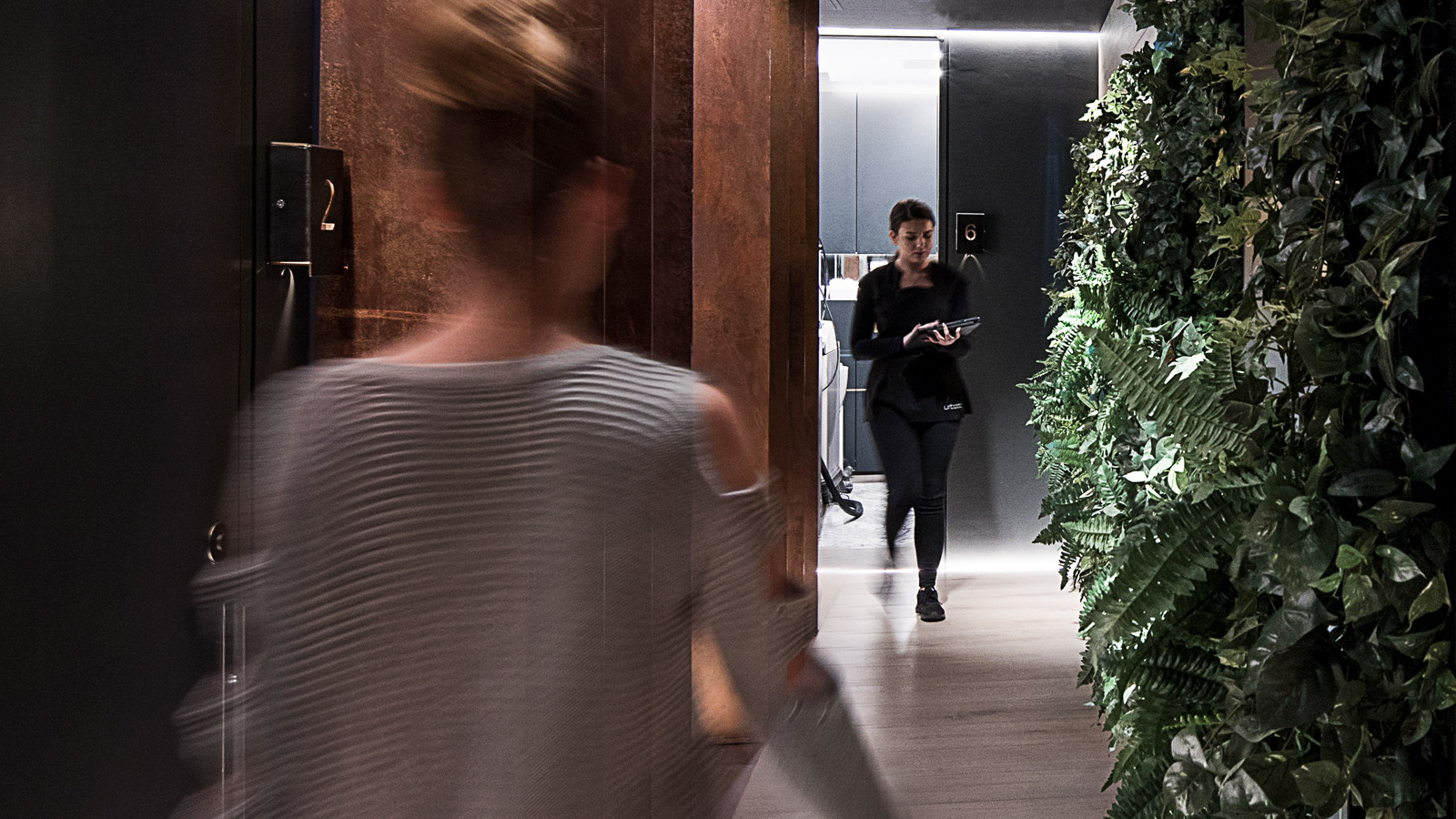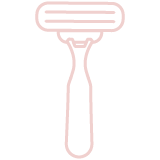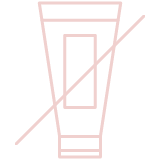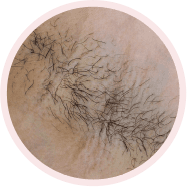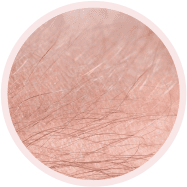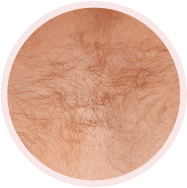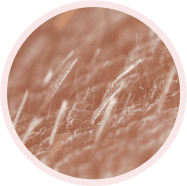Medical Conditions
Some medical conditions and associated medication are not compatible with laser.
To achieve the best results with no surprises, we have a consultation first. We’ll assess your skin and hair to ensure you are suitable, review your medical history to ensure it’s safe and we’ll make a plan with you that will deliver the best results. We’ll also answer any questions you may have about the process.
Pre-Treatment FAQs
Here's a few things to ensure the best results for your treatment.
- After Waxing
- Before Waxing
- Comfort during treatment
- Getting the best results
- Ingrown Hairs
- Medication and medical conditions
- Shaving, waxing & exfoliation during treatment
- Tanning, sun exposure and fake tan
- The Treatment Process
After Waxing
Can I shave in-between waxes?
We know it’s tempting but don’t give in. We don’t recommend shaving in between your waxes, shaving will affect the consistency of your hair growth patterns. If you do shave you also increase the chance of getting ingrown hairs and we all know that’s not fun.
Do I need to avoid anything after my wax appointment?
Directly after waxing your hair follicles remain open so please refrain from the following Hot showers/baths, steam rooms, saunas, swimming pool and exercise for 24hrs after your wax. Exfoliation for 24hrs and use light exfoliation for up to 3 days after waxing. Sun beds or fake tan on the area or expose the area to direct sunlight. Perfumed products or thick creams. Don’t wear tight clothes as they will cause friction on the area. All of the above may cause skin to become irritated in the treated area, it is important that you follow these guidelines to ensure the result from your wax is long lasting and to ensure your skin safety.
How do I exfoliate and how often should I be doing it?
You should exfoliate using gentle to medium pressure on the skin, very rough and aggressive exfoliation is not recommended especially in the bikini area. Regular light exfoliation done 2-3 times a week is more effective than 1 session using a heavy handed approach as this will traumatise your skin. Exfoliating mitts are widely available and when used in conjunction with a light scrub prove to be a very effective combination. If you need something stronger products are available which contain Salicylic Acid (from the willow bark tree) to further help the skin shed its dead layers , this in turn prevents hairs getting trapped underneath the skin.
How do I get rid of ingrown hairs and will the red marks they leave fade away?
Light exfoliation as explained above should help but if you are prone to ingrown hairs it is worthwhile investing in a good after wax product to help the skin chemically exfoliate(Not as in bad chemicals, using an active ingredient in a product) as opposed to mechanically(Scrubbing). This will also help the red marks to fade over time. If you must use a tweezers , ensure that your skin is clean and the tweezers has been disinfected and also that you have a antibac wipe or cream to apply over the area after the hair has been removed, this will ensure that the follicle doesn’t become infected.
Is waxing permanent?
No, waxing can weaken the hair over time but not completely remove it permanently, if you stop waxing hairs will regenerate in the follicles.
What is an ingrown hair?
If you are prone to ingrown hairs you will normally see bumps appear a couple of weeks after waxing these are normal and are nothing to worry about. It is however very important to use a product specifically designed to help with ingrown hairs and begin to exfoliate at this stage otherwise you will find more hairs becoming ingrown.
When can I start exfoliating again?
Depending on how sensitive your skin is after waxing it is quiet safe to start lightly exfoliating about 3-4 days after your wax, just be gentle for the first week or so. We really do recommending exfoliating in between your waxing appointments to avoid ingrown hairs forming under the skin.
When will I need my next wax?
This varies from person to person but an average of 4-6 weeks for most people, you will find the more you wax the cleaner they become and the less frequently you will need them. The trick is not to leave too long of a gap in-between so that you are catching each growth cycle as they are coming through.
Before Waxing
Can I wax if I have had laser hair removal?
Yes, but if at all possible we would recommend continuing with laser on the area until you have achieved the final result you are happy with, if there was originally a mix of light and dark hairs laser would have only successfully removed the darker hairs, laser will have no effect on the lighter hairs so these can be waxed after your course has been completed if needed.
Can someone who has sensitive skin be waxed?
Absolutely, we would recommend that you have a patch test 24 hours before your wax just to ensure everything will be fine, this will put your mind at ease to as it will determine if your skin is suitable or not. Sometimes if you have a sensitive skin the heat of the wax may need to be adjusted so when booking you are booking your appointment or speaking to your therapist mention it to them and they will adjust the temperature accordingly.
Do I have to cancel if I get my period?
Absolutely not, we would ask that you use a tampon. You may be more sensitive but it is not necessary to cancel, It happens all the time and is not a problem at all.
Do I need to do anything before my wax appointment?
We would ask all clients to ensure their skin is clean and free from any oils or moisturisers. Exfoliate lightly about 2-3 days before your wax. We would ask that you trim hair to about ¼ of an inch long, before your wax. Wear loose cotton clothing we would also recommend you wear 100% cotton underwear to avoid any skin irritation if having a bikini wax, if you are having a leg wax we would ask you not to wear nylon tights or skinny jeans afterwards as this could cause an irritation on your legs. Avoiding caffeine before your wax as it makes your pain receptors more sensitive. Some clients will take a mild pain reliever 30mins before their appointment. Refrain from using false tan or using tanning beds before waxing.
How long does my hair have to be to be waxed?
You will need at least 2-3 weeks growth in order to achieve a clean wax, this does vary from person to person. For your first wax we would definitely recommend 3 weeks growth. It is REALLY important for the hairs to be long enough so that the wax can grab them otherwise hairs will break or will not be removed completely. If your hairs are not long enough we recommend rescheduling otherwise you may be disappointed with your result. We would ask that hair be trimmed to about ¼ of an inch long.
I have never been waxed before and am embarrassed?
Don’t be, seriously. We completely understand, what is a everyday occurrence for us is a big deal for you, especially if it is your first time. We do this all day every day so there is no need for you to worry. We will take our time to explain what will happen and ensure you feel at ease. Our therapists are very professional and will make sure you never feel uncomfortable.
I’m pregnant can I wax?
Yes, there is no reason why you can’t get waxed while pregnant, unless you are told not to by your doctor. It might get a little bit more challenging the bigger your bump gets but have no have no fear you’re in safe hands.
Is it hygienic to wax?
Definitely, we have a strict hygiene policy our rules are always obeyed and never compromised. We never double dip our spatulas – so the wax in our pots is 100% completely clean. We wear disposable gloves always. Work areas are completely sanitised with hospital grade disinfectant after every client. Our specialist wax therapists have over 6 years experience and are experts at what they do they would never comprise your safety while waxing.
Is waxing safe?
Absolutely, waxing has been used for years as a method of hair removal. All of our waxing therapists have over 6 years experience and because we are a dedicated hair removal clinic it’s what we do, all day every day. We use the highest quality waxes and only use hot wax for all specialised intimate waxing treatments so you can be assured of the safest most comfortable wax possible.
Is there anything I can do beforehand that will decrease the sensation?
Avoid Caffeine before your wax appointment. Take a mild pain reliever. Avoid waxing if you are premenstrual. Most importantly, Relax, you’re in safe hands.
What happens during a wax appointment?
Firstly we will ask you to fill in some paperwork , your therapist will bring you to a treatment room and ask you to remove your clothing, for intimate waxing we do ask that all items of clothing be removed from the waist down, we pop you onto a treatment couch and give you a towel to cover over the treatment area so you feel comfortable, your therapist will then come in and wax.
What is the difference between a Brazilian and Hollywood wax?
A Brazilian is the removal of the hair in the intimate area, including the labia and bum, a small strip of hair is left, the size and shape depend on your own personal preference. A Hollywood is the removal of all of the hair in this area including labia and bum.
What is the difference between a wax and a maintenance wax?
A full wax is needed by someone who has never been waxed before or for someone that hasn’t been waxed in over a six week period and has full growth. We allocate a full 30mins for this treatment so that you can relax and we can take our time to ensure a clean wax is achieved. A maintenance wax is for someone who has been waxed previously at Urbana within a 4-6 week period. We allocate 20mins for this treatment because we are just maintaining the reduction of the hair rather than having to remove a full growth of hair in the area.
Why is there a price difference?
Basically because you have less hair we have to spend less time waxing. We value all our customers and want to reward them for their loyalty. This along with our loyalty card system is our way of saying Thank you, which we feel is a very important thing to do. We appreciate you coming in to have your regular waxing with us.
Will it hurt?
Honestly, it depends on the person, some people think it’s a breeze and others say, well, let’s just say it doesn’t feel like a massage. The vast majority of people say it’s the anticipation and thought of it which is the worst part, the wax itself is fine. Some parts are worse than others but over time it gets better as the more you wax the hair the weaker it will become. We only use hot wax for all of our intimate waxing treatments this allows the follicle to open more and is a lot less painful than strip waxing. We’re a chatty bunch in here so generally the time passes by before you realise what’s happened. Read More
Comfort during treatment
Can I exercise after laser hair removal sessions?
You should not perform any form of strenuous exercise after laser hair removal treatment for at least 24 hours. As laser works on the principle of using heat to destroy the hair follicles deep beneath the skin’s surface, an increase in the body’s natural temperature by exercising combined with sweat will cause an increase in irritation on the treatment area. This also applies to swimming where the chlorine in the water can cause irritation on the skin during the 24 hours after treatment. Read More
Do I have to cancel my laser hair removal session if I get my period?
Absolutely not, we would ask that you use a tampon if having your bikini area treated. You may be more sensitive but it is not necessary to cancel, it happens all the time and is not a problem. Read More
Does laser hair removal hurt?
When we initially perform a patch test we do this on the most sensitive part of the area to give you a true reflection of what you will be feeling. We adjust settings in accordance with how sensitive you are and what you can manage personally. As with most treatments it depends on the person and on the area being treated but we will always ensure you are comfortable.
The lasers we use all have additional cooling devices to decrease any sensitivity you may feel throughout your treatment. The vast majority of people say it’s the anticipation and thought of it which is the worst part, the actual treatment itself is fine. For the first few pulses the energy can feel a little sharp but over the duration of a session it does get easier to manage.
Read More
Getting the best results
Can Laser Hair Removal Work On Light Hair?
Laser hair removal will work on light hairs that contain dark pigment, laser has no effect on light hairs that are blond, red, grey or white in colour as they don’t contain enough pigment for the laser to absorb into. Read More
Do I need to avoid anything after my laser hair removal treatment?
Directly after any laser hair removal treatment your skin will be sensitive so please refrain from the following.
- Hot showers/baths, steam rooms, saunas, swimming pool and exercise for 24-48hrs
- Don’t exfoliate for 3-4 days and use light exfoliation methods (new bullet) Don’t use sun beds on the area or expose the area to direct sunlight at all while having laser
- Don’t use perfumed products or thick creams for 48hrs
- Don’t wear tight clothes like skinny jeans or nylon tights (if having your legs treated) for 48hrs as they will cause heat build up and friction on the area and may aggravate skin
- All of the above may cause skin to become irritated in the treated area, it is important that you follow these guidelines to ensure your skin safety.
Read More
Do I need to do anything before my first laser treatment?
If you are thinking about laser and wax or use an epilator regularly we would recommended you stop waxing/epilating 4-6 weeks before your first laser hair removal session to ensure your follicles are full and you have enough hair to treat.
Ensure the treatment area is free from tan - real or otherwise and lightly exfoliate approx 5 days before your first session.
Do not apply any moisturiser, cream, oil or lotion to the treatment area, Aloe Vera is the only thing we would recommend if skin is irritated from shaving.
Close shave the area the night before and not the day of treatment, because when you shave you slightly exfoliate and irritate the area so allow the extra time overnight for the skin to regenerate and make treatment more comfortable. Shaving the day of your treatment will cause your skin to feel more sensitive throughout the treatment and may limit the amount of energy we can use due to skin sensitivity.
Read More
How do I exfoliate and how often during laser hair removal should I?
About 7 -10 days after your session the treated hair growth cycle will shed out of the follicle. We would recommend exfoliating using gentle to medium pressure on the skin as very rough and aggressive exfoliation will aggravate it. Regular light exfoliation done 2-3 times a week is more effective than 1 session using a heavy handed approach as this will traumatise your skin.
Exfoliating mitts are widely available and when used in conjunction with a light scrub prove to be a very effective combination. Apply moisturiser after exfoliating to help skin replenish.
Read More
How many laser hair removal sessions will I need?
This is all down to the individual. Below is an average amount of laser sessions for someone who has pale skin, dark hair that is dense, has no underlying medical issues and attends for their sessions and top up sessions at the time frame given to them.
- Face 6-12 Sessions (Most difficult areas to treat, due to hair being finer and more follicles being present)
- Bikini and Underarm: 6-10 (Labia is one of the most difficult areas here, due to skin colour being darker)
- Large areas, legs/arms etc 6-10 (Knees, Upper thighs due to thick skin on knees or finer hairs on thighs)
- Mans Back/Chest 12-15 sessions due to hair being very strong, coarse and resilient to laser.
After these sessions have been completed maintenance sessions are required, most people will need an average of 2-3 maintenance sessions a year.
Is laser hair removal permanent?
The reduction you receive is permanent, but it is impossible to achieve 100% removal of every single follicle in a given area. Over the course of treatment your hair and the amount of it that you have will change dramatically - and we mean dramatically. What starts off as rough, coarse and thick hair will eventually become soft, thin and light hair. You will have areas where the hair has completely disappeared and some areas with sporadic light hairs remain. These hairs will be picked up on your subsequent top up treatments.
Top up laser hair removal treatments are recommended to keep these finer hairs away and are typically needed once or twice a year.
What factors will influence my laser hair removal results?
For the vast majority of people laser hair removal is an amazing and sometimes life changing treatment. Because genetically we are all so different this has a huge impact on the effectiveness of your treatment, there are a number of different factors that are listed below that will determine the level of final result you will receive and how many treatments it will take to get that result. (new bullet) Colour of your Skin
- Colour and diameter of your Hair
- Optimum Fluences (Energy levels)
- Optimum Treatment Intervals (Time between treatments)
- Underlying problems (new para) All of these areas are fully explained when having a consultation with our laser specialists.
Why do I need a consultation and patch test before starting laser hair removal treatment?
This is probably the most important part of your laser hair removal treatment, on consultation we check through your medical history, assess your skin and hair to ensure you are suitable and answer any questions you may have regarding treatment.
We want to make sure you have all the relevant information to allow you to make an informed decision that laser is right for you. After your consultation you should be equipped with all the knowledge you need to understand how laser works and the science behind it.
Your patch test is also vitally important as it allows us to test your skin for any sensitivity from the laser and also will ensure you are a suitable candidate for treatment. (new para) If you are putting your trust in us and investing in Laser we feel it’s only right that we invest the time to explain things fully and make sure all your questions are answered.
Will I need top up sessions?
Yes, when we have completed a set of sessions (usually 6-8) and are happy with the treatment outcome you may need to have top up or maintenance sessions a couple of times a year. This depends on the person and the hair growth they had initially. Hairs that remain should be sporadic, fine and light and should be very slow to grow.
Ingrown Hairs
How do I get rid of ingrown hairs and do the red marks they leave fade away?
Light exfoliation should help but if you are prone to ingrown hairs it is worthwhile investing in a good product to help the skin chemically exfoliate (not meaning use of chemicals, but an active ingredient in the product) as opposed to mechanically (Scrubbing). This will also help the red marks to fade over time.
What should I do if I get ingrown hairs during laser hair removal treatment?
This usually happens if you have transferred from waxing to shaving, it takes a little while for your skin to adjust. It also happens when treated hairs are shedding and if you don’t exfoliate regularly enough these hairs will tend to get trapped in the skin. If you are prone to ingrown hairs you will normally see bumps appear about a week after a laser hair removal session these are nothing to worry about. It is however very important to use a product specifically designed to help with ingrown hairs and begin to exfoliate at this stage otherwise you will find more hairs becoming ingrown. It is important that you stop using these products a week before your session and recommence using them about a week after your session also. Light exfoliation methods are best to free any ingrown hairs and hydrating the skin afterwards is a must.
Medication and medical conditions
Can I take Ibuprofen before my session of laser hair removal?
Please do not take Ibuprofen for 48 hours before your laser hair removal session, this medication may cause bruising after laser for certain people.
Shaving, waxing & exfoliation during treatment
Can I shave in-between my laser hair removal sessions?
Absolutely, you can shave as much as you like while having laser treatment.
We recommend shaving the treatment area the night before treatment, not the day of because when you shave you slightly exfoliate and irritate the area so allow the extra time overnight for the skin to regenerate and make treatment more comfortable. Shaving the day of your treatment will cause your skin to feel more sensitive during your laser hair removal treatments and may limit the amount of energy we can use due to skin sensitivity.
Read More
Can I wax after laser hair removal?
Yes, but if at all possible we would recommend continuing with laser on the area until you receive the level of reduction you are happy with, providing the remaining hairs still contain pigment. On treatment areas where there was originally a mix of light and dark hairs, laser will only target and treat the darker ones. Lighter hairs will remain and it is fine to wax these.
If you are undergoing a course of laser hair removal treatments please do not wax the area in between sessions as this will affect your results.
Read More
Can I wax during my laser hair removal treatment?
No, shaving is the only method of hair removal recommended while having laser hair removal at our Dublin of Drogheda clinics. Waxing in between your sessions will affect hair growth patterns and affect results. Read More
How soon after laser hair removal can I exfoliate?
Depending on how sensitive your skin is after laser it is quiet safe to start lightly exfoliating about 3-4 days after your treatment, just be gentle for the first week or so. We really do recommend exfoliating in between your laser appointments to avoid ingrown hairs forming under the skin. Read More
Should I shave after my laser hair removal treatment?
You can shave the area after laser treatment but must leave it for a minimum of 48 hours after treatment before shaving the areas.
After your laser hair removal treatment, the hair may still appear to be “growing”. It may also appear darker and thicker in some areas such as bikini line. This is a natural process of laser hair removal and the hair is now in a shedding stage. It appears darker and thicker as it has been charred by the laser (this is good). It may take 10 -21 days for the hair to fall out of the follicle which will leave a noticeably smoother skin’s surface. During this time it is perfectly fine to shave the areas you have had treated and this along with regular exfoliation of the areas will assist in the hair shedding process.
Read More
Why can’t I wax or pluck in-between my laser hair removal sessions?
When you wax or pluck, the hair is completely removed from the follicle in order for the laser to be effective hair follicles must have hair present so that they can be targeted. If you have waxed or plucked the treatment area you would have to wait 6-8 weeks for follicles to produce a new hair. Read More
Tanning, sun exposure and fake tan
Can I tan while having laser hair removal treatment?
No, tanning is not recommended while having laser hair removal. Tanning does have an impact on the amount of sessions needed and will impact on your results. This is more prevalent when you begin your treatments as it is important to have at least 6-8 treatments with a 6-8 week gap in-between.
When you tan and stimulate the melanin within the skin cells we would have wait at least 8-10 weeks before repeating a patch test. This long gap in-between sessions can see an increase in density and growth in the hair. And because we are missing growth cycles due to gap in treatments you may see growth cycles of hair coming through at the same time. This is normal and will be the reason why potentially more sessions may be needed.
Can I use fake tan while having laser hair removal treatment?
Yes, you can apply Fake Tan approximately 4-5 days after your session and use it in between each session. It is extremely important that you don’t use any tan for a week before your treatment and ensure that you are exfoliating your skin daily to remove any residue. If there is any residue on the skin we cannot perform your treatment until all tan is removed.
Can I use sun beds while having laser hair removal treatment?
No, using sunbeds is extremely dangerous while having laser hair removal treatments and must be avoided at all times. You will seriously damage your skin if you use sunbeds during the course of your treatments.
The Treatment Process
Do I need to do anything before my first laser treatment?
If you are thinking about laser and wax or use an epilator regularly we would recommended you stop waxing/epilating 4-6 weeks before your first laser hair removal session to ensure your follicles are full and you have enough hair to treat.
Ensure the treatment area is free from tan - real or otherwise and lightly exfoliate approx 5 days before your first session.
Do not apply any moisturiser, cream, oil or lotion to the treatment area, Aloe Vera is the only thing we would recommend if skin is irritated from shaving.
Close shave the area the night before and not the day of treatment, because when you shave you slightly exfoliate and irritate the area so allow the extra time overnight for the skin to regenerate and make treatment more comfortable. Shaving the day of your treatment will cause your skin to feel more sensitive throughout the treatment and may limit the amount of energy we can use due to skin sensitivity.
Read More
How long should I leave between each laser hair removal session?
Again this differs from person to person but on average a 4-6 week gap initially depending on the area being treated.
We would recommend every 4 weeks for the face for at least 6 sessions. This does depend on the rate of regrowth. After that we may extend the gaps in-between sessions to a 6-8 week interval or longer if necessary. We would recommend every 6 weeks on the body depending on the density of hair and regrowth pattern and again extend the gaps in-between sessions to a 8-10 week interval. Your treatment area will be continually assessed throughout your course of treatment and your therapist will recommend when you should return for your next session.
How many laser hair removal sessions will I need?
This is all down to the individual. Below is an average amount of laser sessions for someone who has pale skin, dark hair that is dense, has no underlying medical issues and attends for their sessions and top up sessions at the time frame given to them.
- Face 6-12 Sessions (Most difficult areas to treat, due to hair being finer and more follicles being present)
- Bikini and Underarm: 6-10 (Labia is one of the most difficult areas here, due to skin colour being darker)
- Large areas, legs/arms etc 6-10 (Knees, Upper thighs due to thick skin on knees or finer hairs on thighs)
- Mans Back/Chest 12-15 sessions due to hair being very strong, coarse and resilient to laser.
After these sessions have been completed maintenance sessions are required, most people will need an average of 2-3 maintenance sessions a year.
I have never had laser hair removal and I'm nervous.
We completely understand, if you have never had laser before it is a pretty daunting experience, but there is nothing to be worried about. When we carry out your initial patch test we explain how our laser hair removal treatment is performed and you will get a sense of how it feels. If you are experiencing any real discomfort we can adjust settings so that you have a comfortable starting point.
Our main aim for your first few sessions is really to slow hair growth down and thin it out. This can be done by introducing a lower level of heat into the skin. Your first few sessions should be comfortable and you should feel a slight/medium pinch depending on the density of your hair.
We will take our time to explain what will happen and ensure you feel at ease. Our therapists are very professional and will make sure you never feel uncomfortable.
Is laser hair removal permanent?
The reduction you receive is permanent, but it is impossible to achieve 100% removal of every single follicle in a given area. Over the course of treatment your hair and the amount of it that you have will change dramatically - and we mean dramatically. What starts off as rough, coarse and thick hair will eventually become soft, thin and light hair. You will have areas where the hair has completely disappeared and some areas with sporadic light hairs remain. These hairs will be picked up on your subsequent top up treatments.
Top up laser hair removal treatments are recommended to keep these finer hairs away and are typically needed once or twice a year.
Whats the difference between IPL and laser hair removal?
Lasers are most selective and more effective at absorbing into melanin, meaning fewer treatments are required for long-term hair removal.
There has been more published clinical evidence to support effectiveness of laser treatments.
Lasers penetrate deeper into tissues to specifically target hair structures. Alex 755nm, NdYAG1064nm and Diode 810nm penetrate approximately 4-5mm specifically design to target hair structures, while most IPL’s (Intense Pulsed Light) only target 2mm which is not deep enough to target these structures effectively.
Lasers have more advanced cooling systems meaning more comfortable treatments.
Why do I need a consultation and patch test before starting laser hair removal treatment?
This is probably the most important part of your laser hair removal treatment, on consultation we check through your medical history, assess your skin and hair to ensure you are suitable and answer any questions you may have regarding treatment.
We want to make sure you have all the relevant information to allow you to make an informed decision that laser is right for you. After your consultation you should be equipped with all the knowledge you need to understand how laser works and the science behind it.
Your patch test is also vitally important as it allows us to test your skin for any sensitivity from the laser and also will ensure you are a suitable candidate for treatment. (new para) If you are putting your trust in us and investing in Laser we feel it’s only right that we invest the time to explain things fully and make sure all your questions are answered.
Pre-Treatment FAQs
Here's a few things to ensure the best results for your treatment.
- After Waxing
- Before Waxing
- Comfort during treatment
- Getting the best results
- Ingrown Hairs
- Medication and medical conditions
- Shaving, waxing & exfoliation during treatment
- Tanning, sun exposure and fake tan
- The Treatment Process
After Waxing
Can I shave in-between waxes?
We know it’s tempting but don’t give in. We don’t recommend shaving in between your waxes, shaving will affect the consistency of your hair growth patterns. If you do shave you also increase the chance of getting ingrown hairs and we all know that’s not fun.
Do I need to avoid anything after my wax appointment?
Directly after waxing your hair follicles remain open so please refrain from the following Hot showers/baths, steam rooms, saunas, swimming pool and exercise for 24hrs after your wax. Exfoliation for 24hrs and use light exfoliation for up to 3 days after waxing. Sun beds or fake tan on the area or expose the area to direct sunlight. Perfumed products or thick creams. Don’t wear tight clothes as they will cause friction on the area. All of the above may cause skin to become irritated in the treated area, it is important that you follow these guidelines to ensure the result from your wax is long lasting and to ensure your skin safety.
How do I exfoliate and how often should I be doing it?
You should exfoliate using gentle to medium pressure on the skin, very rough and aggressive exfoliation is not recommended especially in the bikini area. Regular light exfoliation done 2-3 times a week is more effective than 1 session using a heavy handed approach as this will traumatise your skin. Exfoliating mitts are widely available and when used in conjunction with a light scrub prove to be a very effective combination. If you need something stronger products are available which contain Salicylic Acid (from the willow bark tree) to further help the skin shed its dead layers , this in turn prevents hairs getting trapped underneath the skin.
How do I get rid of ingrown hairs and will the red marks they leave fade away?
Light exfoliation as explained above should help but if you are prone to ingrown hairs it is worthwhile investing in a good after wax product to help the skin chemically exfoliate(Not as in bad chemicals, using an active ingredient in a product) as opposed to mechanically(Scrubbing). This will also help the red marks to fade over time. If you must use a tweezers , ensure that your skin is clean and the tweezers has been disinfected and also that you have a antibac wipe or cream to apply over the area after the hair has been removed, this will ensure that the follicle doesn’t become infected.
Is waxing permanent?
No, waxing can weaken the hair over time but not completely remove it permanently, if you stop waxing hairs will regenerate in the follicles.
What is an ingrown hair?
If you are prone to ingrown hairs you will normally see bumps appear a couple of weeks after waxing these are normal and are nothing to worry about. It is however very important to use a product specifically designed to help with ingrown hairs and begin to exfoliate at this stage otherwise you will find more hairs becoming ingrown.
When can I start exfoliating again?
Depending on how sensitive your skin is after waxing it is quiet safe to start lightly exfoliating about 3-4 days after your wax, just be gentle for the first week or so. We really do recommending exfoliating in between your waxing appointments to avoid ingrown hairs forming under the skin.
When will I need my next wax?
This varies from person to person but an average of 4-6 weeks for most people, you will find the more you wax the cleaner they become and the less frequently you will need them. The trick is not to leave too long of a gap in-between so that you are catching each growth cycle as they are coming through.
Before Waxing
Can I wax if I have had laser hair removal?
Yes, but if at all possible we would recommend continuing with laser on the area until you have achieved the final result you are happy with, if there was originally a mix of light and dark hairs laser would have only successfully removed the darker hairs, laser will have no effect on the lighter hairs so these can be waxed after your course has been completed if needed.
Can someone who has sensitive skin be waxed?
Absolutely, we would recommend that you have a patch test 24 hours before your wax just to ensure everything will be fine, this will put your mind at ease to as it will determine if your skin is suitable or not. Sometimes if you have a sensitive skin the heat of the wax may need to be adjusted so when booking you are booking your appointment or speaking to your therapist mention it to them and they will adjust the temperature accordingly.
Do I have to cancel if I get my period?
Absolutely not, we would ask that you use a tampon. You may be more sensitive but it is not necessary to cancel, It happens all the time and is not a problem at all.
Do I need to do anything before my wax appointment?
We would ask all clients to ensure their skin is clean and free from any oils or moisturisers. Exfoliate lightly about 2-3 days before your wax. We would ask that you trim hair to about ¼ of an inch long, before your wax. Wear loose cotton clothing we would also recommend you wear 100% cotton underwear to avoid any skin irritation if having a bikini wax, if you are having a leg wax we would ask you not to wear nylon tights or skinny jeans afterwards as this could cause an irritation on your legs. Avoiding caffeine before your wax as it makes your pain receptors more sensitive. Some clients will take a mild pain reliever 30mins before their appointment. Refrain from using false tan or using tanning beds before waxing.
How long does my hair have to be to be waxed?
You will need at least 2-3 weeks growth in order to achieve a clean wax, this does vary from person to person. For your first wax we would definitely recommend 3 weeks growth. It is REALLY important for the hairs to be long enough so that the wax can grab them otherwise hairs will break or will not be removed completely. If your hairs are not long enough we recommend rescheduling otherwise you may be disappointed with your result. We would ask that hair be trimmed to about ¼ of an inch long.
I have never been waxed before and am embarrassed?
Don’t be, seriously. We completely understand, what is a everyday occurrence for us is a big deal for you, especially if it is your first time. We do this all day every day so there is no need for you to worry. We will take our time to explain what will happen and ensure you feel at ease. Our therapists are very professional and will make sure you never feel uncomfortable.
I’m pregnant can I wax?
Yes, there is no reason why you can’t get waxed while pregnant, unless you are told not to by your doctor. It might get a little bit more challenging the bigger your bump gets but have no have no fear you’re in safe hands.
Is it hygienic to wax?
Definitely, we have a strict hygiene policy our rules are always obeyed and never compromised. We never double dip our spatulas – so the wax in our pots is 100% completely clean. We wear disposable gloves always. Work areas are completely sanitised with hospital grade disinfectant after every client. Our specialist wax therapists have over 6 years experience and are experts at what they do they would never comprise your safety while waxing.
Is waxing safe?
Absolutely, waxing has been used for years as a method of hair removal. All of our waxing therapists have over 6 years experience and because we are a dedicated hair removal clinic it’s what we do, all day every day. We use the highest quality waxes and only use hot wax for all specialised intimate waxing treatments so you can be assured of the safest most comfortable wax possible.
Is there anything I can do beforehand that will decrease the sensation?
Avoid Caffeine before your wax appointment. Take a mild pain reliever. Avoid waxing if you are premenstrual. Most importantly, Relax, you’re in safe hands.
What happens during a wax appointment?
Firstly we will ask you to fill in some paperwork , your therapist will bring you to a treatment room and ask you to remove your clothing, for intimate waxing we do ask that all items of clothing be removed from the waist down, we pop you onto a treatment couch and give you a towel to cover over the treatment area so you feel comfortable, your therapist will then come in and wax.
What is the difference between a Brazilian and Hollywood wax?
A Brazilian is the removal of the hair in the intimate area, including the labia and bum, a small strip of hair is left, the size and shape depend on your own personal preference. A Hollywood is the removal of all of the hair in this area including labia and bum.
What is the difference between a wax and a maintenance wax?
A full wax is needed by someone who has never been waxed before or for someone that hasn’t been waxed in over a six week period and has full growth. We allocate a full 30mins for this treatment so that you can relax and we can take our time to ensure a clean wax is achieved. A maintenance wax is for someone who has been waxed previously at Urbana within a 4-6 week period. We allocate 20mins for this treatment because we are just maintaining the reduction of the hair rather than having to remove a full growth of hair in the area.
Why is there a price difference?
Basically because you have less hair we have to spend less time waxing. We value all our customers and want to reward them for their loyalty. This along with our loyalty card system is our way of saying Thank you, which we feel is a very important thing to do. We appreciate you coming in to have your regular waxing with us.
Will it hurt?
Honestly, it depends on the person, some people think it’s a breeze and others say, well, let’s just say it doesn’t feel like a massage. The vast majority of people say it’s the anticipation and thought of it which is the worst part, the wax itself is fine. Some parts are worse than others but over time it gets better as the more you wax the hair the weaker it will become. We only use hot wax for all of our intimate waxing treatments this allows the follicle to open more and is a lot less painful than strip waxing. We’re a chatty bunch in here so generally the time passes by before you realise what’s happened. Read More
Comfort during treatment
Can I exercise after laser hair removal sessions?
You should not perform any form of strenuous exercise after laser hair removal treatment for at least 24 hours. As laser works on the principle of using heat to destroy the hair follicles deep beneath the skin’s surface, an increase in the body’s natural temperature by exercising combined with sweat will cause an increase in irritation on the treatment area. This also applies to swimming where the chlorine in the water can cause irritation on the skin during the 24 hours after treatment. Read More
Do I have to cancel my laser hair removal session if I get my period?
Absolutely not, we would ask that you use a tampon if having your bikini area treated. You may be more sensitive but it is not necessary to cancel, it happens all the time and is not a problem. Read More
Does laser hair removal hurt?
When we initially perform a patch test we do this on the most sensitive part of the area to give you a true reflection of what you will be feeling. We adjust settings in accordance with how sensitive you are and what you can manage personally. As with most treatments it depends on the person and on the area being treated but we will always ensure you are comfortable.
The lasers we use all have additional cooling devices to decrease any sensitivity you may feel throughout your treatment. The vast majority of people say it’s the anticipation and thought of it which is the worst part, the actual treatment itself is fine. For the first few pulses the energy can feel a little sharp but over the duration of a session it does get easier to manage.
Read More
Getting the best results
Can Laser Hair Removal Work On Light Hair?
Laser hair removal will work on light hairs that contain dark pigment, laser has no effect on light hairs that are blond, red, grey or white in colour as they don’t contain enough pigment for the laser to absorb into. Read More
Do I need to avoid anything after my laser hair removal treatment?
Directly after any laser hair removal treatment your skin will be sensitive so please refrain from the following.
- Hot showers/baths, steam rooms, saunas, swimming pool and exercise for 24-48hrs
- Don’t exfoliate for 3-4 days and use light exfoliation methods (new bullet) Don’t use sun beds on the area or expose the area to direct sunlight at all while having laser
- Don’t use perfumed products or thick creams for 48hrs
- Don’t wear tight clothes like skinny jeans or nylon tights (if having your legs treated) for 48hrs as they will cause heat build up and friction on the area and may aggravate skin
- All of the above may cause skin to become irritated in the treated area, it is important that you follow these guidelines to ensure your skin safety.
Read More
Do I need to do anything before my first laser treatment?
If you are thinking about laser and wax or use an epilator regularly we would recommended you stop waxing/epilating 4-6 weeks before your first laser hair removal session to ensure your follicles are full and you have enough hair to treat.
Ensure the treatment area is free from tan - real or otherwise and lightly exfoliate approx 5 days before your first session.
Do not apply any moisturiser, cream, oil or lotion to the treatment area, Aloe Vera is the only thing we would recommend if skin is irritated from shaving.
Close shave the area the night before and not the day of treatment, because when you shave you slightly exfoliate and irritate the area so allow the extra time overnight for the skin to regenerate and make treatment more comfortable. Shaving the day of your treatment will cause your skin to feel more sensitive throughout the treatment and may limit the amount of energy we can use due to skin sensitivity.
Read More
How do I exfoliate and how often during laser hair removal should I?
About 7 -10 days after your session the treated hair growth cycle will shed out of the follicle. We would recommend exfoliating using gentle to medium pressure on the skin as very rough and aggressive exfoliation will aggravate it. Regular light exfoliation done 2-3 times a week is more effective than 1 session using a heavy handed approach as this will traumatise your skin.
Exfoliating mitts are widely available and when used in conjunction with a light scrub prove to be a very effective combination. Apply moisturiser after exfoliating to help skin replenish.
Read More
How many laser hair removal sessions will I need?
This is all down to the individual. Below is an average amount of laser sessions for someone who has pale skin, dark hair that is dense, has no underlying medical issues and attends for their sessions and top up sessions at the time frame given to them.
- Face 6-12 Sessions (Most difficult areas to treat, due to hair being finer and more follicles being present)
- Bikini and Underarm: 6-10 (Labia is one of the most difficult areas here, due to skin colour being darker)
- Large areas, legs/arms etc 6-10 (Knees, Upper thighs due to thick skin on knees or finer hairs on thighs)
- Mans Back/Chest 12-15 sessions due to hair being very strong, coarse and resilient to laser.
After these sessions have been completed maintenance sessions are required, most people will need an average of 2-3 maintenance sessions a year.
Is laser hair removal permanent?
The reduction you receive is permanent, but it is impossible to achieve 100% removal of every single follicle in a given area. Over the course of treatment your hair and the amount of it that you have will change dramatically - and we mean dramatically. What starts off as rough, coarse and thick hair will eventually become soft, thin and light hair. You will have areas where the hair has completely disappeared and some areas with sporadic light hairs remain. These hairs will be picked up on your subsequent top up treatments.
Top up laser hair removal treatments are recommended to keep these finer hairs away and are typically needed once or twice a year.
What factors will influence my laser hair removal results?
For the vast majority of people laser hair removal is an amazing and sometimes life changing treatment. Because genetically we are all so different this has a huge impact on the effectiveness of your treatment, there are a number of different factors that are listed below that will determine the level of final result you will receive and how many treatments it will take to get that result. (new bullet) Colour of your Skin
- Colour and diameter of your Hair
- Optimum Fluences (Energy levels)
- Optimum Treatment Intervals (Time between treatments)
- Underlying problems (new para) All of these areas are fully explained when having a consultation with our laser specialists.
Why do I need a consultation and patch test before starting laser hair removal treatment?
This is probably the most important part of your laser hair removal treatment, on consultation we check through your medical history, assess your skin and hair to ensure you are suitable and answer any questions you may have regarding treatment.
We want to make sure you have all the relevant information to allow you to make an informed decision that laser is right for you. After your consultation you should be equipped with all the knowledge you need to understand how laser works and the science behind it.
Your patch test is also vitally important as it allows us to test your skin for any sensitivity from the laser and also will ensure you are a suitable candidate for treatment. (new para) If you are putting your trust in us and investing in Laser we feel it’s only right that we invest the time to explain things fully and make sure all your questions are answered.
Will I need top up sessions?
Yes, when we have completed a set of sessions (usually 6-8) and are happy with the treatment outcome you may need to have top up or maintenance sessions a couple of times a year. This depends on the person and the hair growth they had initially. Hairs that remain should be sporadic, fine and light and should be very slow to grow.
Ingrown Hairs
How do I get rid of ingrown hairs and do the red marks they leave fade away?
Light exfoliation should help but if you are prone to ingrown hairs it is worthwhile investing in a good product to help the skin chemically exfoliate (not meaning use of chemicals, but an active ingredient in the product) as opposed to mechanically (Scrubbing). This will also help the red marks to fade over time.
What should I do if I get ingrown hairs during laser hair removal treatment?
This usually happens if you have transferred from waxing to shaving, it takes a little while for your skin to adjust. It also happens when treated hairs are shedding and if you don’t exfoliate regularly enough these hairs will tend to get trapped in the skin. If you are prone to ingrown hairs you will normally see bumps appear about a week after a laser hair removal session these are nothing to worry about. It is however very important to use a product specifically designed to help with ingrown hairs and begin to exfoliate at this stage otherwise you will find more hairs becoming ingrown. It is important that you stop using these products a week before your session and recommence using them about a week after your session also. Light exfoliation methods are best to free any ingrown hairs and hydrating the skin afterwards is a must.
Medication and medical conditions
Can I take Ibuprofen before my session of laser hair removal?
Please do not take Ibuprofen for 48 hours before your laser hair removal session, this medication may cause bruising after laser for certain people.
Shaving, waxing & exfoliation during treatment
Can I shave in-between my laser hair removal sessions?
Absolutely, you can shave as much as you like while having laser treatment.
We recommend shaving the treatment area the night before treatment, not the day of because when you shave you slightly exfoliate and irritate the area so allow the extra time overnight for the skin to regenerate and make treatment more comfortable. Shaving the day of your treatment will cause your skin to feel more sensitive during your laser hair removal treatments and may limit the amount of energy we can use due to skin sensitivity.
Read More
Can I wax after laser hair removal?
Yes, but if at all possible we would recommend continuing with laser on the area until you receive the level of reduction you are happy with, providing the remaining hairs still contain pigment. On treatment areas where there was originally a mix of light and dark hairs, laser will only target and treat the darker ones. Lighter hairs will remain and it is fine to wax these.
If you are undergoing a course of laser hair removal treatments please do not wax the area in between sessions as this will affect your results.
Read More
Can I wax during my laser hair removal treatment?
No, shaving is the only method of hair removal recommended while having laser hair removal at our Dublin of Drogheda clinics. Waxing in between your sessions will affect hair growth patterns and affect results. Read More
How soon after laser hair removal can I exfoliate?
Depending on how sensitive your skin is after laser it is quiet safe to start lightly exfoliating about 3-4 days after your treatment, just be gentle for the first week or so. We really do recommend exfoliating in between your laser appointments to avoid ingrown hairs forming under the skin. Read More
Should I shave after my laser hair removal treatment?
You can shave the area after laser treatment but must leave it for a minimum of 48 hours after treatment before shaving the areas.
After your laser hair removal treatment, the hair may still appear to be “growing”. It may also appear darker and thicker in some areas such as bikini line. This is a natural process of laser hair removal and the hair is now in a shedding stage. It appears darker and thicker as it has been charred by the laser (this is good). It may take 10 -21 days for the hair to fall out of the follicle which will leave a noticeably smoother skin’s surface. During this time it is perfectly fine to shave the areas you have had treated and this along with regular exfoliation of the areas will assist in the hair shedding process.
Read More
Why can’t I wax or pluck in-between my laser hair removal sessions?
When you wax or pluck, the hair is completely removed from the follicle in order for the laser to be effective hair follicles must have hair present so that they can be targeted. If you have waxed or plucked the treatment area you would have to wait 6-8 weeks for follicles to produce a new hair. Read More
Tanning, sun exposure and fake tan
Can I tan while having laser hair removal treatment?
No, tanning is not recommended while having laser hair removal. Tanning does have an impact on the amount of sessions needed and will impact on your results. This is more prevalent when you begin your treatments as it is important to have at least 6-8 treatments with a 6-8 week gap in-between.
When you tan and stimulate the melanin within the skin cells we would have wait at least 8-10 weeks before repeating a patch test. This long gap in-between sessions can see an increase in density and growth in the hair. And because we are missing growth cycles due to gap in treatments you may see growth cycles of hair coming through at the same time. This is normal and will be the reason why potentially more sessions may be needed.
Can I use fake tan while having laser hair removal treatment?
Yes, you can apply Fake Tan approximately 4-5 days after your session and use it in between each session. It is extremely important that you don’t use any tan for a week before your treatment and ensure that you are exfoliating your skin daily to remove any residue. If there is any residue on the skin we cannot perform your treatment until all tan is removed.
Can I use sun beds while having laser hair removal treatment?
No, using sunbeds is extremely dangerous while having laser hair removal treatments and must be avoided at all times. You will seriously damage your skin if you use sunbeds during the course of your treatments.
The Treatment Process
Do I need to do anything before my first laser treatment?
If you are thinking about laser and wax or use an epilator regularly we would recommended you stop waxing/epilating 4-6 weeks before your first laser hair removal session to ensure your follicles are full and you have enough hair to treat.
Ensure the treatment area is free from tan - real or otherwise and lightly exfoliate approx 5 days before your first session.
Do not apply any moisturiser, cream, oil or lotion to the treatment area, Aloe Vera is the only thing we would recommend if skin is irritated from shaving.
Close shave the area the night before and not the day of treatment, because when you shave you slightly exfoliate and irritate the area so allow the extra time overnight for the skin to regenerate and make treatment more comfortable. Shaving the day of your treatment will cause your skin to feel more sensitive throughout the treatment and may limit the amount of energy we can use due to skin sensitivity.
Read More
How long should I leave between each laser hair removal session?
Again this differs from person to person but on average a 4-6 week gap initially depending on the area being treated.
We would recommend every 4 weeks for the face for at least 6 sessions. This does depend on the rate of regrowth. After that we may extend the gaps in-between sessions to a 6-8 week interval or longer if necessary. We would recommend every 6 weeks on the body depending on the density of hair and regrowth pattern and again extend the gaps in-between sessions to a 8-10 week interval. Your treatment area will be continually assessed throughout your course of treatment and your therapist will recommend when you should return for your next session.
How many laser hair removal sessions will I need?
This is all down to the individual. Below is an average amount of laser sessions for someone who has pale skin, dark hair that is dense, has no underlying medical issues and attends for their sessions and top up sessions at the time frame given to them.
- Face 6-12 Sessions (Most difficult areas to treat, due to hair being finer and more follicles being present)
- Bikini and Underarm: 6-10 (Labia is one of the most difficult areas here, due to skin colour being darker)
- Large areas, legs/arms etc 6-10 (Knees, Upper thighs due to thick skin on knees or finer hairs on thighs)
- Mans Back/Chest 12-15 sessions due to hair being very strong, coarse and resilient to laser.
After these sessions have been completed maintenance sessions are required, most people will need an average of 2-3 maintenance sessions a year.
I have never had laser hair removal and I'm nervous.
We completely understand, if you have never had laser before it is a pretty daunting experience, but there is nothing to be worried about. When we carry out your initial patch test we explain how our laser hair removal treatment is performed and you will get a sense of how it feels. If you are experiencing any real discomfort we can adjust settings so that you have a comfortable starting point.
Our main aim for your first few sessions is really to slow hair growth down and thin it out. This can be done by introducing a lower level of heat into the skin. Your first few sessions should be comfortable and you should feel a slight/medium pinch depending on the density of your hair.
We will take our time to explain what will happen and ensure you feel at ease. Our therapists are very professional and will make sure you never feel uncomfortable.
Is laser hair removal permanent?
The reduction you receive is permanent, but it is impossible to achieve 100% removal of every single follicle in a given area. Over the course of treatment your hair and the amount of it that you have will change dramatically - and we mean dramatically. What starts off as rough, coarse and thick hair will eventually become soft, thin and light hair. You will have areas where the hair has completely disappeared and some areas with sporadic light hairs remain. These hairs will be picked up on your subsequent top up treatments.
Top up laser hair removal treatments are recommended to keep these finer hairs away and are typically needed once or twice a year.
Whats the difference between IPL and laser hair removal?
Lasers are most selective and more effective at absorbing into melanin, meaning fewer treatments are required for long-term hair removal.
There has been more published clinical evidence to support effectiveness of laser treatments.
Lasers penetrate deeper into tissues to specifically target hair structures. Alex 755nm, NdYAG1064nm and Diode 810nm penetrate approximately 4-5mm specifically design to target hair structures, while most IPL’s (Intense Pulsed Light) only target 2mm which is not deep enough to target these structures effectively.
Lasers have more advanced cooling systems meaning more comfortable treatments.
Why do I need a consultation and patch test before starting laser hair removal treatment?
This is probably the most important part of your laser hair removal treatment, on consultation we check through your medical history, assess your skin and hair to ensure you are suitable and answer any questions you may have regarding treatment.
We want to make sure you have all the relevant information to allow you to make an informed decision that laser is right for you. After your consultation you should be equipped with all the knowledge you need to understand how laser works and the science behind it.
Your patch test is also vitally important as it allows us to test your skin for any sensitivity from the laser and also will ensure you are a suitable candidate for treatment. (new para) If you are putting your trust in us and investing in Laser we feel it’s only right that we invest the time to explain things fully and make sure all your questions are answered.
Blog
9th January 2023
What is the success rate of laser hair removal?
Laser hair removal has a very high success rate. The majority of people will...
7th August 2021
Does laser hair removal hurt?
Laser hair removal should not hurt you during treatment. It is common for some...
26th July 2021
What is the difference between an IPL and laser?
There are a number of differences between IPL (Intense pulsed light) and laser....
